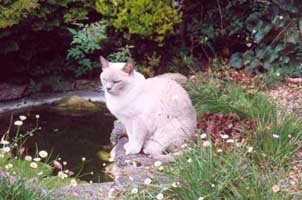Ill cats
From :
Cat Fanciers
Feline Urinary Syndrome (FUS)
Feline urinary syndrome or FUS is the name given to a group of symptoms that occur in the cat secondary to inflammation, irritation, and/or obstruction of the lower urinary tract (urinary bladder, urethra, and penile urethra). A cat with FUS can exhibit one, some, or even all of the symptoms.
FUS is NOT a specific diagnosis: there are many known and some unknown factors that may cause or contribute to FUS. Any cause resulting in particulate debris in the urine is capable of causing obstruction in the male cat.
Males are much more likely to get this disease than females. There is no known means of prevention. Treatment can vary from
diet to surgery. Cats usually recover if the disease is caught in time; often the cat must be watched for any recurrence of FUS.
Symptoms
May appear periodically during the life of the cat.
Females: straining to urinate, blood in the urine, frequent trips to the litter box with only small amounts voided, loss of litterbox habits.
Males: In addition to the above symptoms, small particles may lodge in the male urethra and cause complete obstruction with the inability to pass urine-this is a life and death situation if not treated quickly.
Obstruction usually occurs in the male cat and is most often confined to the site where the urethra narrows as it enters the bulbourethral gland and penis; small particles that can easily pass out of the bladder and transverse the urethra congregate at the bottleneck of the penile urethra to cause complete blockage. (note that the female urethra opens widely into the vagina with no bottleneck).
Symptoms of obstruction are much more intense than those of bladder inflammation alone; this is an emergency requiring immediate steps to relieve the obstruction. Symptoms include:
Frequent non-producing straining-no urine produced, discomfort, pain, howling.
Gentle feeling of the cats abdomen reveals a tennis ball size structure which is the overdistended urinary bladder.
Subsequent depression, vomiting and/or diarrhea, dehydration, loss of appetite, uremic poisoning, and coma may develop rapidly within 24 hours.
Death results from uremic poisoning; advanced uremic poisoning may not be reversible even with relief of the obstruction and intensive care. Bladders can be permanently damaged as a result.
Causes of FUS
In general: any condition that causes stricture, malfunction, inflammation, or obstruction of the urethra. In addition, any condition that causes inflammation, malfunction, or abnormal anatomy of the urinary bladder.
Known causes
- Struvite crystals accompanied by red blood cells--generally caused by a diet too high in magnesium relative to the pH of the urine.
- Fish-flavored foods tend to be worse
- The ability of a given diet to cause problems in an individual cat is highly variable: only those cats with a history of this kind of FUS may respond well to strictly dietary management. Many cats do not have problems with a diet that may produce FUS in some individuals.
- Bladder stones, may occur from struvite crystals, or be secondary to bladder infections. There are metabolic disorders (not all are understood) that result in a higher concentration of a given mineral that can remain in solution; hence stones are formed. Diet may greatly modify the concentration of a given mineral in solution in the urine. Water intake may modify the concentration of all minerals in the urine, and bacterial infection increases the risk of stone formation.
- Anatomical abnormalities such as congenital malformations of the bladder and/or urethra (early neutering is NOT a factor) OR acquired strictures of the urethra and/or scarring of the bladder.
- Trauma.
- Neurolgenic problems affecting the act of urination (difficult to diagnose except at institutions capable of urethral pressure profiles)
- Primary bacterial infection--RARE!
- Tumors (benign/malignant)
- Protein matrix plug (generally urethral obstruction of males); can be from non-mineral protein debris, viral-based, other causes are unknown.
- Suspected or unknown factors include non-bacterial infections, toxins, stress, and seasonal influences.
Management of FUS
- Obstruction of the male cat is a medical emergency. The obstruction must be relieved immediately.
- Failure to produce a good stream of urine after relief of obstruction is indicative of urethral stricture and/or stones or matrex plugs. Failure of bladder to empty after relief of obstruction suggests bladder paralysis (usually temporary unless present prior to obstruction). In either event, a urinary catheter must be placed to allow continual urination.
- Treatment of uremic poisoning requires IV fluid therapy with monitoring of blood levels of waste products until uremia is no longer present.
- Permanent urethral damage with stricture, inability to dislodge a urethral obstruction, or inability to prevent recurring obstructions are all indications for perineal urethrostomy (amputation of the penis and narrow portion of the urethra to create a female-sized opening for urination). This procedure is usually effective in preventing reobstruction of the male cat, but this procedure should be a last resort
- If FUS is indicated without obstruction, 75 to 80% of FUS cats without obstruction may be sucessfully managed by diet alone if urine reveals typical crystals and red blood cells. Unobstructed male cats or non-uremic obstructed males who have a good urine stream and bladder function after relief of an early obstruction may be managed as above initially. Cats who are symptom-free after 7 to 10 days of dietary management and who have normal follow-up urines at 21 days, may be maintained indefinitely with dietary management only.
- DL-Methionine is often prescribed for cats with FUS. Most commonly, FUS-specific diets contain this acidifier. Antibiotics may be used. Distilled water for FUS-prone cats is often recommended as well.

















